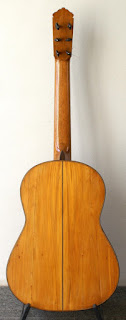Antonio Mateu Ramis was a Barcelona based luthier.
Little can be found about his activities but a classical
guitar by this builder was highly praised by the famous
Alexandre Lagoya. (Collection Sebastian Stenzel)
Very lightly built in the typical flamenco tradition.
Spruce top and ebony fingerboard.
A dry tone and quickly responding.



Very lightly built in the typical flamenco tradition.
Spruce top and ebony fingerboard.
A dry tone and quickly responding.

Apart from the nice Rosette you can see the double
scratchplates as is common on flamenco models.
scratchplates as is common on flamenco models.

On this label the luthier marked this instrument no. 13 being
dated the first of july 1953. In fact this luthier stopped in about
dated the first of july 1953. In fact this luthier stopped in about
1965. He had no successors. A classical guitar of this builder
The back of this guitar wasn't free from cracks either
but the damage could be easily cured and finished.

On this guitar the use of cypress can be clearly seen.
This is still tradition in flamenco guitar building though
it is possible to order a "negro" flamenco model
that has been equipped with a rosewood back.
Ebony tuning pegs to lighten the guitar in fact
This is still tradition in flamenco guitar building though
it is possible to order a "negro" flamenco model
that has been equipped with a rosewood back.
Ebony tuning pegs to lighten the guitar in fact
isn't the right solution but at the same time
proof for a certain kind of quality.
Jaime Ribot / Salvador Ibanez 1908
The guitar in question in unrestored condition.
The Jaime Ribot guitar that appears to have similar
ornamentations as some guitars of other Valencian
makers: Francesco Pau and of course Salvador Ibanez.
The Jaime Ribot label, a bit damaged.
Again, but now with the strings in between. You can easily
make pictures with your mobile telephone by simply sliding
your telephone below the strings and then make a picture.
These pictures are NOT from the guitar in question!
The guitar presented with the bridge off as it was
easy to remove it. It was already party loose.
The body before the crack repairings took place.
The label in this guitar. Photographed and shopped
to make it clearer thus giving more details.
This label must have been used between 1905 - 1910.
Some reparations (inserts) were needed and therefore
the back has to be French polished from the start.
Strange is the unevenness of the inlays on both sides of the
string tie block. I've noticed it on other guitars from Ibanez
guitars of that period. The inserts necessary can be studied
here. More easy to do without the bridge glued on.
The head and the newly placed frets as half of them were
already missing and moreover, I had to make a neck to
body angle correction. Fo that purpose I shaved away
material of the fingerboard towards the head.
I've shortened the headstock with about 1 mm in order
to get rid of disturbing damages that occur when placing
a guitar frequently against a wall.
A new quality topnut that has to be there on
a concert guitar of this age.
Though the back has been taken off, a picture with the
label sticked in from the sound hole has to be there.
This happens so often! In this case the two transverse braces
were partly loose and then string tension can cause these
problems much easier. To prevent this in the future I placed
an extra wide but thin layer between the two transverse bars
in the upper bout
Another move was to strengthen the soundhole
edges as when the space for a rosette is carved too
deep it severely weakens that spot. The cleat
beyond has been placed at the end of a crack.
Every single glue block that attach the soundboard to
the sides must be checked and reglued if necessary. The
transverse bars above the sound hole had to be reglued.
And the same insert on the other side.
A knob at the borttom intended for use with a holding
strap. Wether if this is original can be discussed of course.
The holes a bit higher placed are the traces of a formerly
placed tailpiece, probably for metal strings...
No spruce heel operation, often done by Valencian
makers to speed up production processes.
And a picture of the other side of course.
The new added bindings around the back.
New proper fretwork.
A nice shot of the ornamentation and the Brazilian
rosewood fingerboard used here.
Inserts coloured a bit better...
The beautiful rosette with some newly placed
pieces of pearl inlay.
The sides that are in pristine condition.
































Geen opmerkingen:
Een reactie posten